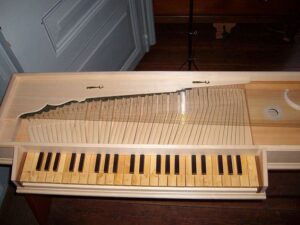Google goes Classical. Or, at least High Baroque. Think of the millions of people who have seen Google’s doodle-logo (still up today) showing a fortepiano played by a wigged fellow, with the words Google etched on the side of the instrument. Think of the slice of those millions who stopped to wonder “Why did Google do this?” And then think of the even tinier slice who bothered to find out.
Still, that’s a lot of people learning that Google was celebrating the anniversary of Bartolomeo Cristofori (1655-1731), the Italian inventor generally credited with creating the hammer mechanism that resulted in a new instrument we call “the piano.” It’s his 360th birthday so why shouldn’t Google draw a new logo and shout it out to the world?
Cristofori! Not a name exactly on everyone’s tongue, is it? But everyone knows the modern piano that descended from his early 18th-century invention. Called a fortepiano or pianoforte, the fragile new keyboard had a hammer mechanism (click on the box to see the Google animation) that allowed the player to regulate and shade the dynamics, or volume, of the notes using finger force to control the strike.
The predominant keyboard instrument of the day, the harpsichord (clavecin in French) had a mechanism that plucked the string with a quill. Whether you depressed it gently with your pinkie or hit it with a hammer, you’d end up with the same “pluck” (except, in the latter case, you also probably smash the key).
Harpsichords were indispensable to Baroque musical style and a status symbol for the aristocracy. Builders developed fascinating effects, including the ability to pluck two strings with one key, sometimes with the strings tuned an octave apart (that created a grand sound!).
But what you couldn’t do with a harpsichord was control the dynamics pitch by pitch. You couldn’t start the first note of a melodic line quietly, then let the melody swell to loud in the middle, and pull it back to a quiet ending. The violin, flute, and oboe could do that (with bow or air pressure). The human voice certainly could do that. But the harpsichord could not.

There was a keyboard instrument that could, though, and it had been around since mid-Renaissance. Known as a Clavichord, it was a simple, table-top keyboard whose keys triggered delicate metal hammers that touched the strings. Think of it as a hammered dulcimer with lots of little hammers, but built upside down.
The clavichord met several needs. It was an economic instrument (easy to build); it was a small instrument and fit the small spaces most people had in their dwellings; and it was an extremely quiet instrument, which meant it could be played and not disturb the neighbors (or even the baby sleeping in the next room).
Clavichords were workhorses, and generations of our most beloved composers (like Johann Sebastian Bach) grew up owning them. But they could not be used for public performance: at their loudest, they were quiet, and if played softly, they were almost inaudible.

Enter the fortepiano. Cristofori gets the credit in textbooks, but like every invention, there were many people working on the same idea. Enamored of its “soft” (piano) and “loud” (forte) possibilities, it became known as the fortepiano. And of course more innovations would come with each generation, until it grew into the monster concert grand we see in today’s symphony halls. The most important was a “double-escapement” which meant the falling hammer, after striking a string, would be caught at a mid point and could be easily, and quickly, tripped up to resound the note. This mechanism opened up a new level of how fast how notes could repeat, and brought on an era of virtuosic composition with earth-shatteringly difficult piano passages in the 19th century. The second innovation that changed everything was the cast-iron frame, which meant the strings could be “strung” at great pressure, and therefore sustain much more force of attack. The forte part of the fortepiano got even louder.
And yet the “soft” part of the name—the piano—ultimately stuck!
I hope you saw the Google logo, and watched the hammer mechanism go up and down. You’ll hear an endless loop of a mono-rhythmic version of the melody known as Jesu Joy of Man’s Desiring. You probably hear this melody every time you go to a wedding! Ironically, this piece was written by J. S. Bach for the organ. It decorates the famous hymn tune, which is played by the feet on the pedals. Bach did not compose for the new pianoforte, although he did know the instruments, and his initial dubiousness grew into moderate enthusiasm late in life as they began to improve mechanically.
So, thank you Google for reminding us of the humble origins of this extraordinary force in Western Cultural History: the piano.



